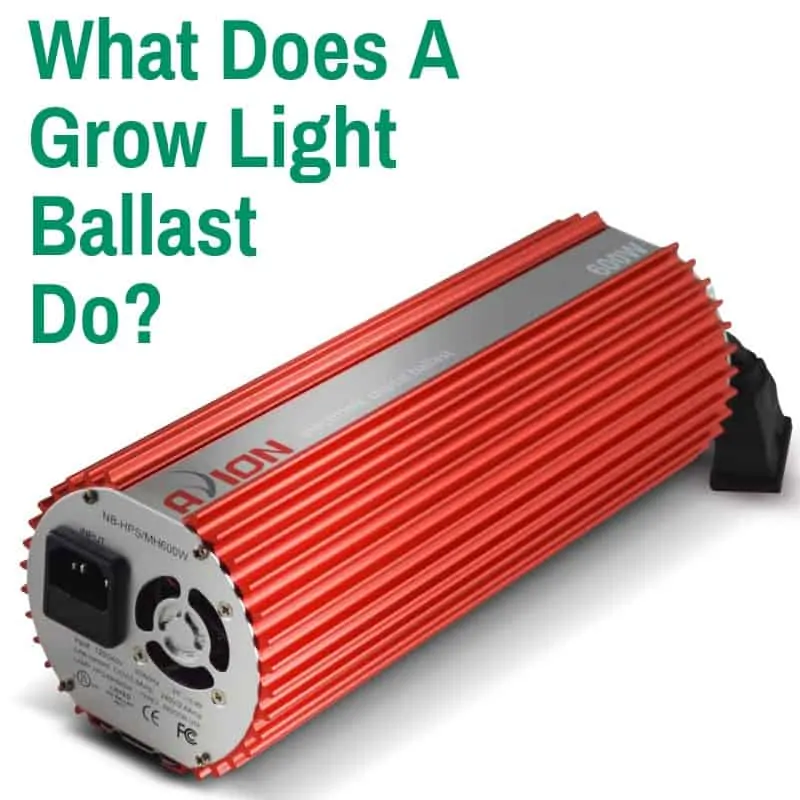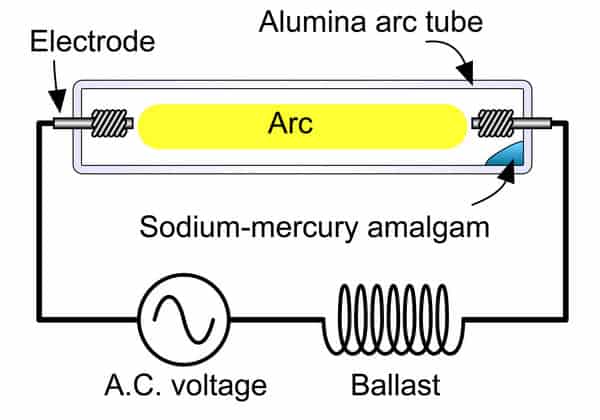 Most grow lights need a ballast.
Most grow lights need a ballast.
With fluorescent lights the ballast is built-in and LED lights don’t need one.
But if you’re thinking of going with HID plant lights, you’ll have to buy the ballast separately.
The best way to do this is to get an HID grow light kit that includes everything you need (MH bulb, HPS bulb, ballast, reflector, hangers and timer), but if you already have some of those components, you can get the ballast on its own.
Either way, you’re going to need one.
But why do you need one?
What does a grow light ballast actually do?
Contents
What Is A Grow Light Ballast And What Does It Do?
In short: ballasts power the light bulbs.
Grow lamps are low-resistance devices when they are burning, but they need a high voltage to get started. A ballast provides both.
When you power up a lamp, the ballast provides a high enough voltage to get the arc started (for more on HID bulbs and how they work, see this article). When the arc first strikes, the sodium is solid, but it quickly melts and vaporizes.

In the gaseous state, the resistance of the lamp drops and it requires much less power to keep running. The ballast ensures that the lamp only receives the current it needs and nothing more.
Without the ballast to regulate the amount of electricity going into the bulb, the light would continue to increase in intensity until the bulb blows.
When starting up, the HID bulb requires more power than your outlet provides, so the ballast ramps up what it gets from the wall to give the lamp what it needs to light up. Once it is running, it regulates whatever it gets from the wall (there are sometimes variations) and ensures the lamp always receives a steady supply of electricity.
When HID bulbs age, they actually require more power to run. The ballast automatically increases the amount of power to the bulb as it ages.
Once the bulb reaches a point where it needs too much power, the ballast shuts down to prevent an accident. In this case, you can restart the bulb, but the ballast will quickly shut it down again. This means it’s time to get a new bulb.
There are two types of ballasts: magnetic and electronic.
Magnetic Vs Electronic Ballast
Both have their advantages and disadvantages, but most of us are better off using electronic ballasts. They run cooler and are more efficient (higher output while using less power).
Most are also dimmable (meaning they can run lower wattage bulbs as well) and can run both HPS and MH bulbs. Read our article “Should I Dim My Ballast?” for the pros and cons of doing this.
But they have disadvantages as well and they are definitely not the best choice for everyone. Read on to see which ballast would be best for you.
Magnetic Ballast: How It Works
Magnetic ballasts have a large spool of wire that is wrapped around steel sheets. This generator creates the large amount of voltage needed to power up an HID bulb. They use a canister made from plastic or metal to regulate the electricity.
Magnetic ballasts are considered old school and have fallen out of favor. They are bulky and they generate a lot of heat.
They do have some advantages, though. They are rugged and usually last much longer than electronic ballasts, running for years even in harsh weather.
More importantly, the are designed to meet the ANSI (American National Standards Institute) standards, ensuring that the lamp and ballast operate together correctly.
The problem is that metal halide and high pressure sodium have different requirements and thus require separate ballasts. There are switchable magnetic ballasts available that can operate both types of bulbs, but they are actually built to the HPS specifications and are thus not really specified for MH bulbs, though they can run them.
Electronic Ballasts
Instead of a magnetic coil, electronic ballasts have semiconductors and microchips that provide the high voltage required by HID lamps. As such, the inside of an electronic ballast looks more like a computer than what you would traditionally expect a ballast to look like.
Not having the heavy coil makes them much smaller and lighter than magnetic ballasts. They also run a lot cooler.
The main drawback of an electronic ballast is that there is currently no ANSI standard for their compatibility with HPS and MH lamps, at least not for high-wattage (250+ watts) versions. As a result, they are all made differently, which leads to inconsistent bulb performance.
This is another reason we generally recommend buying a complete lighting system. That way you get a ballast that was meant to operate the included bulbs.
On the plus side, almost all electronic ballasts are switchable, meaning they can operate both metal-halide and high-pressure sodium bulbs without issue. Most are also dimmable these days, which allows you to run multiple wattages of bulbs. It does not generally mean you should dim the ballast to run a bulb at less than full power.
This is not the case for ceramic metal halide bulbs, though. They require special ballasts with a much lower frequency. Again, just get a kit.
What Is A Digital Ballast?
You will often see electronic ballasts labeled as “digital ballasts”, but very few actually are.
A ballast is really only digital if it contains a microprocessor. Most ballasts labeled “digital” do not.
Do LED Grow Lights Need A Ballast?
No, LED grow lights do not need a ballast. Everything you need is included in the fixture, so there are no additional components to buy.
If you have an existing T5 fluorescent fixture and are planning on replacing the fluorescent bulbs with T5 LED grow light tubes, you may have to actually bypass the ballast in the fixture. Some LED tubes work with the ballast, but for many, you will have to disconnect it for them to work.
What Does A Grow Light Ballast Do: Final Thoughts
As you can see, grow light ballasts perform a vital function and you can not operate an HID lighting system without one. Luckily, they are always included in plant light kits, so you don’t generally have to worry about finding one that is compatible with your reflector and bulbs.
Of course, you can make you life much easier by simply using LED lights instead. These days, they are much more efficient and prices have come down so much that they do not cost much more either. They will easily pay for themselves within a year, due to the cost savings of using less power, generating less heat and not having to change bulbs. Check out the best ones here.
Photo Credit
- Image 1: By Avion Ballast, CC BY-SA 3.0, Link
- Image 2: By Sakurambo at en.wikipedia [GFDL or CC-BY-SA-3.0], via Wikimedia Commons
Chris says
I guess as a bulb ages something changes about the gas that requires the ballast to produce more power run it? Would explain why a lamp that was working fine, after being shut off, won’t start again. It draws too much to start and the ballast shuts down at some point. Good article.
Steven says
Yes exactly. It’s actually the high initial voltage pulse to start up the lamp that changes the properties of the arc tub over time.